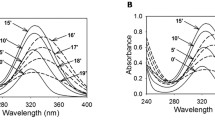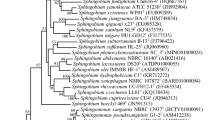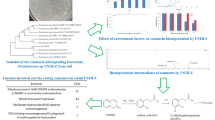Abstract
The widespread agricultural application of carbofuran and concomitant contamination of surface and ground waters has raised health concerns due to the reported toxic effects of this insecticide and its degradation products. Most bacteria that degrade carbofuran only perform partial degradation involving carbamate hydrolysis without breakdown of the resulting phenolic metabolite. The capacity to mineralize carbofuran beyond the benzofuran ring has been reported for some bacterial strains, especially sphingomonads, and some common metabolites, including carbofuran phenol, were identified. In the current study, the catabolism of carbofuran by Novosphingobium sp. KN65.2 (LMG 28221), a strain isolated from a carbofuran-exposed Vietnamese soil and utilizing the compound as a sole carbon and nitrogen source, was studied. Several KN65.2 plasposon mutants with diminished or abolished capacity to degrade and mineralize carbofuran were generated and characterized. Metabolic profiling of representative mutants revealed new metabolic intermediates, in addition to the initial hydrolysis product carbofuran phenol. The promiscuous carbofuran-hydrolyzing enzyme Mcd, which is present in several bacteria lacking carbofuran ring mineralization capacity, is not encoded by the Novosphingobium sp. KN65.2 genome. An alternative hydrolase gene required for this step was not identified, but the constitutively expressed genes of the unique cfd operon, including the oxygenase genes cfdC and cfdE, could be linked to further degradation of the phenolic metabolite. A third involved oxygenase gene, cfdI, and the transporter gene cftA, encoding a TonB-dependent outer membrane receptor with potential regulatory function, are located outside the cfd cluster. This study has revealed the first dedicated carbofuran catabolic genes and provides insight in the early steps of benzofuran ring degradation.






Similar content being viewed by others
References
Aylward FO, McDonald BR, Adams SM, Valenzuela A, Schmidt RA, Goodwin LA, Woyke T, Currie CR, Suen G, Poulsen M (2013) Comparison of 26 sphingomonad genomes reveals diverse environmental adaptations and biodegradative capabilities. Appl Environ Microbiol 79(12):3724–3733. doi:10.1128/Aem.00518-13
Bermingham A, Derrick JP (2002) The folic acid biosynthesis pathway in bacteria: evaluation of potential for antibacterial drug discovery. Bioessays 24:637–648. doi:10.1002/Bies.10114
Caldas SS, Demoliner A, Costa FP, D'Oca MGM, Primel EG (2010) Pesticide residue determination in groundwater using solid-phase extraction and high-performance liquid chromatography with diode array detector and liquid chromatography-tandem mass spectrometry. J Braz Chem Soc 21(4):642–650. doi:10.1590/S0103-50532010000400009
Castellanos J, Sánchez J, Uribe D, Moreno L, Melgarejo LM (2013) Characterization of carbofuran degrading bacteria obtained from potato cultivated soils with different pesticide application records. Rev Fac Nal Agr Medellín 66:6899–6908
Chapalamadugu S, Chaudhry GR (1992) Microbiological and biotechnological aspects of metabolism of carbamates and organophosphates. Crit Rev Biotechnol 12(5–6):357–389. doi:10.3109/07388559209114232
Chaudhry GR, Ali HD (1988) Bacterial metabolism of carbofuran. Appl Environ Microbiol 54(1414):1419
Chaudhry GR, Mateen A, Kaskar B, Sardessai M, Bloda M, Bhatti AR, Walia SK (2002) Induction of carbofuran oxidation to 4-hydroxycarbofuran by Pseudomonas sp. 50432. FEMS Microbiol Lett 214(2):171–176. doi:10.1016/s0378-1097(02)00851-0
Chen HP, Zhu SH, Casabon I, Hallam SJ, Crocker FH, Mohn WW, Indest KJ, Eltis LD (2012) Genomic and transcriptomic studies of an RDX (hexahydro-1,3,5-trinitro-1,3,5-triazine)-degrading actinobacterium. Appl Environ Microbiol 78(21):7798–7800. doi:10.1128/Aem.02120-12
Chiron S, Valverde A, FernandezAlba A, Barcelo D (1995) Automated sample preparation for monitoring groundwater pollution by carbamate insecticides and their transformation products. J AOAC Int 78(6):1346–1352
Chowdhury MAZ, Banik S, Uddin B, Moniruzzaman M, Karim N, Gan SH (2012) Organophosphorus and carbamate pesticide residues detected in water samples collected from paddy and vegetable fields of the Savar and Dhamrai Upazilas in Bangladesh. Int J Environ Res Public Health 9(9):3318–3329. doi:10.3390/ijerph9093318
Cuthbertson L, Nodwell JR (2013) The TetR family of regulators. Microbiol Mol Biol Rev 77(3):440–475. doi:10.1128/Mmbr.00018-13
D'Argenio V, Petrillo M, Cantiello P, Naso B, Cozzuto L, Notomista E, Paolella G, Di Donato A, Salvatore F (2011) De novo sequencing and assembly of the whole genome of Novosphingobium sp. strain PP1Y. J Bacteriol 193(16):4296
Dasgupta S, Meisner C, Wheeler D, Xuyen K, Lam NT (2007) Pesticide poisoning of farm workers - implications of blood test results from Vietnam. Int J Hyg Environ Health 210(2):121–132. doi:10.1016/j.ijheh.2006.08.006
De Llasera MPG, Bernal-Gonzalez M (2001) Presence of carbamate pesticides in environmental waters from the northwest of Mexico: determination by liquid chromatography. Water Res 35(8):1933–1940
Desaint S, Hartmann A, Parekh NR, Fournier JC (2000) Genetic diversity of carbofuran-degrading soil bacteria. FEMS Microbiol Ecol 34(2):173–180. doi:10.1111/j.1574-6941.2000.tb00767.x
Desaint S, Arrault S, Siblot S, Fournier JC (2003) Genetic transfer of the mcd gene in soil. J Appl Microbiol 95(1):102–108. doi:10.1046/j.1365-2672.2003.01965.x
Dresen C, Lin LY, D'Angelo I, Tocheva EI, Strynadka N, Eltis LD (2010) A flavin-dependent monooxygenase from Mycobacterium tuberculosis involved in cholesterol catabolism. J Biol Chem 285(29):22264–22275. doi:10.1074/jbc.M109.099028
Fahmy MAH, Fukuto TR, Myers RO, March RB (1970) Selective toxicity of new N-phosphorothioylcarbamate esters. J Agric Food Chem 18(5):793–796. doi:10.1021/jf60171a014
Feng XH, Ou LT, Ogram A (1997) Plasmid-mediated mineralization of carbofuran by Sphingomonas sp. strain CF06. Appl Environ Microbiol 63(4):1332–1337
Fida TT, Breugelmans P, Lavigne R, van der Meer JR, De Mot R, Vaysse PJ, Springael D (2014) Identification of opsA, a gene involved in solute stress mitigation and survival in soil, in the polycyclic aromatic hydrocarbon-degrading Novosphingobium sp. strain LH128. Appl Environ Microbiol 80(11):3350–3361. doi:10.1128/AEM.00306-14
Gabriel FL, Cyris M, Jonkers N, Giger W, Guenther K, Kohler HP (2007) Elucidation of the ipso-substitution mechanism for side-chain cleavage of alpha-quaternary 4-nonylphenols and 4-t-butoxyphenol in Sphingobium xenophagum Bayram. Appl Environ Microbiol 73(10):3320–3326. doi:10.1128/AEM.02994-06
Gao JF, Ellis LBM, Wackett LP (2011) The university of Minnesota pathway prediction system: multi-level prediction and visualization. Nucleic Acids Res 39:W406–W411. doi:10.1093/Nar/Gkr200
Goad RT, Goad JT, Atieh BH, Gupta RC (2004) Carbofuran-induced endocrine disruption in adult male rats. Toxicol Mech Methods 14(4):233–239. doi:10.1080/15376520490434476
Guindon S, Gascuel O (2003) A simple, fast, and accurate algorithm to estimate large phylogenies by maximum likelihood. Syst Biol 52(5):696–704. doi:10.1080/10635150390235520
Gupta RC (1994) Carbofuran toxicity. J Toxicol Environ Health 43(4):383–418
Hamed RB, Batchelar ET, Clifton IJ, Schofield CJ (2008) Mechanisms and structures of crotonase superfamily enzymes—how nature controls enolate and oxyanion reactivity. Cell Mol Life Sci 65:2507–2527. doi:10.1007/s00018-008-8082-6
Hartmann EM, Armengaud J (2014) Shotgun proteomics suggests involvement of additional enzymes in dioxin degradation by Sphingomonas wittichii RW1. Environ Microbiol 16:162–176. doi:10.1111/1462-2920.12264
Hashimoto M, Fukui M, Hayano K, Hayatsu M (2002) Nucleotide sequence and genetic structure of a novel carbaryl hydrolase gene (cehA) from Rhizobium sp. strain AC100. Appl Environ Microbiol 68(3):1220–1227. doi:10.1128/Aem.68.3.1220-1227.2002
Hashimoto M, Mizutani A, Tago K, Ohnishi-Kameyama M, Shimojo T, Hayatsu M (2006) Cloning and nucleotide sequence of carbaryl hydrolase gene (cahA) from Arthrobacter sp. RC100. J Biosci Bioeng 101:410–414. doi:10.1263/Jbb.101.410
Head IM, Cain RB, Suett DL (1992) Characterization of a carbofuran-degrading bacterium and investigation of the role of plasmids in catabolism of the insecticide carbofuran. Arch Microbiol 158(4):302–308. doi:10.1007/Bf00245249
Heider J (2001) A new family of CoA-transferases. FEBS Lett 509(3):345–349. doi:10.1016/s0014-5793(01)03178-7
Helbling DE, Hollender J, Kohler HPE, Singer H, Fenner K (2010) High-throughput identification of microbial transformation products of organic micropollutants. Environ Sci Technol 44:6621–6627. doi:10.1021/es100970m
Held JM, Schilling B, D'Souza AK, Srinivasan T, Behring JB, Sorensen DJ, Benz CC, Gibson BW (2013) Label-free quantitation and mapping of the ErbB2 tumor receptor by multiple protease digestion with data-dependent (MS1) and data-independent (MS2) acquisitions. Int J Proteomics 2013:791985. doi:10.1155/2013/791985
Kaczmarczyk A, Campagne S, Danza F, Metzger LC, Vorholt JA, Francez-Charlot A (2011) Role of Sphingomonas sp. strain Fr1 PhyR-NepR-sigmaEcfG cascade in general stress response and identification of a negative regulator of PhyR. J Bacteriol 193(23):6629–6638. doi:10.1128/JB.06006-11
Karns JS, Tomasek PH (1991) Carbofuran hydrolase—purification and properties. J Agric Food Chem 39:1004–1008. doi:10.1021/Jf00005a041
Karns JS, Mulbry WW, Nelson JO, Kearney PC (1986) Metabolism of carbofuran by a pure bacterial culture. Pestic Biochem Physiol 25(2):211–217. doi:10.1016/0048-3575(86)90048-9
Kaur B, Khera A, Sandhir R (2012) Attenuation of cellular antioxidant defense mechanisms in kidney of rats intoxicated with carbofuran. J Biochem Mol Toxicol 26(10):393–398. doi:10.1002/jbt.21433
Kim IS, Ryu JY, Hur HG, Gu MB, Kim SD, Shim JH (2004) Sphingomonas sp. strain SB5 degrades carbofuran to a new metabolite by hydrolysis at the furanyl ring. J Agric Food Chem 52:2309–2314. doi:10.1021/jf035502l
Koebnik R (2005) TonB-dependent trans-envelope signalling: the exception or the rule? Trends Microbiol 13:343–347. doi:10.1016/j.tim.2005.06.005
Larsen RA, Wilson MM, Guss AM, Metcalf WW (2002) Genetic analysis of pigment biosynthesis in Xanthobacter autotrophicus Py2 using a new, highly efficient transposon mutagenesis system that is functional in a wide variety of bacteria. Arch Microbiol 178(3):193–201. doi:10.1007/s00203-002-0442-2
Luo YR, Kang SG, Kim SJ, Kim MR, Li N, Lee JH, Kwon KK (2012) Genome sequence of benzo(a)pyrene-degrading bacterium Novosphingobium pentaromativorans US6-1. J Bacteriol 194(4):907. doi:10.1128/JB.06476-11
Masai E, Sasaki M, Minakawa Y, Abe T, Sonoki T, Miyauchi K, Katayama Y, Fukuda M (2004) A novel tetrahydrofolate-dependent O-demethylase gene is essential for growth of Sphingomonas paucimobilis SYK-6 with syringate. J Bacteriol 186(9):2757–2765
Milatovic D, Gupta RC, Dekundy A, Montine TJ, Dettbarn WD (2005) Carbofuran-induced oxidative stress in slow and fast skeletal muscles: prevention by memantine and atropine. Toxicol 208:13–24. doi:10.1016/j.tox.2004.11.004
Naqvi T, Cheesman MJ, Williams MR, Campbell PM, Ahmed S, Russell RJ, Scott C, Oakeshott JG (2009) Heterologous expression of the methyl carbamate-degrading hydrolase Mcd. J Biotechnol 144(2):89–95. doi:10.1016/j.jbiotec.2009.09.009
Noinaj N, Guillier M, Barnard TJ, Buchanan SK (2010) TonB-dependent transporters: regulation, structure, and function. Annu Rev Microbiol 64:43–60. doi:10.1146/annurev.micro.112408.134247
Ogram AV, Duan YP, Trabue SL, Feng X, Castro H, Ou LT (2000) Carbofuran degradation mediated by three related plasmid systems. FEMS Microbiol Ecol 32(3):197–203. doi:10.1111/j.1574-6941.2000.tb00712.x
Parekh NR, Hartmann A, Charnay MP, Fournier JC (1995) Diversity of carbofuran-degrading soil bacteria and detection of plasmid-encoded sequences homologous to the mcd gene. FEMS Microbiol Ecol 17(3):149–160. doi:10.1111/j.1574-6941.1995.tb00138.x
Park MR, Lee S, Han TH, Oh BT, Shim JH, Kim IS (2006) A new intermediate in the degradation of carbofuran by Sphingomonas sp. strain SB5. J Microbiol Biotechnol 16(8):1306–1310
Plangklang P, Reungsang A (2012) Isolation and characterisation of a carbofuran degrading Burkholderia sp. PCL3 from carbofuran-phytoremediated rhizosphere soil. Chem Ecol 28:253–266. doi:10.1080/02757540.2011.645032
Ramanand K, Sharmila M, Singh N, Sethunathan N (1991) Metabolism of carbamate insecticides by resting cells and cell-free preparations of a soil bacterium, Arthrobacter sp. Bull Environ Contam Toxicol 46(3):380–386
Ran T, Gao Y, Marsh M, Zhu W, Wang M, Mao X, Xu L, Xu D, Wang W (2013) Crystal structures of Cg1458 reveal a catalytic lid domain and a common catalytic mechanism for the FAH family. Biochem J 449(1):51–60. doi:10.1042/BJ20120913
Ricken B, Corvini PFX, Cichocka D, Parisi M, Lenz M, Wyss D, Martinez-Lavanchy PM, Muller JA, Shahgaldian P, Tulli LG, Kohler HPE, Kolvenbach BA (2013) ipso-Hydroxylation and subsequent fragmentation: a novel microbial strategy to eliminate sulfonamide antibiotics. Appl Environ Microbiol 79(18):5550–5558. doi:10.1128/Aem.00911-13
Salama AK (1998) Metabolism of carbofuran by Aspergillus niger and Fusarium graminearum. J Environ Sci Health B 33:253–266. doi:10.1080/03601239809373142
Sambrook J, Russell D (2001) Molecular cloning: a laboratory manual, 3rd edn. Cold Spring Harbor Laboratory, Cold Spring Harbor, New York
Saxena A, Anand S, Dua A, Sangwan N, Khan F, Lal R (2013) Novosphingobium lindaniclasticum sp. nov., a hexachlorocyclohexane (HCH)-degrading bacterium isolated from an HCH dumpsite. Int J Syst Evol Microbiol 63:2160–2167. doi:10.1099/ijs.0.045443-0
Seo J, Jeon J, Kim S-D, Kang S, Han J, Hur H-G (2007) Fungal biodegradation of carbofuran and carbofuran phenol by the fungus Mucor ramannianus: identification of metabolites. Water Sci Technol 55(1–2):163–167. doi:10.2166/wst.2007.051
Shin DH, Kim DU, Seong CN, Song HG, Ka JO (2012) Genetic and phenotypic diversity of carbofuran-degrading bacteria isolated from agricultural soils. J Microbiol Biotechnol 22(4):448–456. doi:10.4014/jmb.1108.08087
Simon R, Priefer U, Pühler A (1983) A broad host range mobilization system for in-vivo genetic engineering: transposon mutagenesis in Gram-negative bacteria. Nat Biotechnol 1:784–791. doi:10.1038/nbt1183-784
Tariq MI, Afzal S, Hussain I (2006) Degradation and persistence of cotton pesticides in sandy loam soils from Punjab, Pakistan. Environ Res 100:184–196. doi:10.1016/j.envres.2005.05.002
Tomasek PH, Karns JS (1989) Cloning of a carbofuran hydrolase gene from Achromobacter sp. strain WM111 and its expression in Gram-negative bacteria. J Bacteriol 171(7):4038–4044
Topp E, Hanson RS, Ringelberg DB, White DC, Wheatcroft R (1993) Isolation and characterization of an N-methylcarbamate insecticide-degrading methylotrophic bacterium. Appl Environ Microbiol 59(10):3339–3349
Untergasser A, Cutcutache I, Koressaar T, Ye J, Faircloth BC, Remm M, Rozen SG (2012) Primer3 - new capabilities and interfaces. Nucleic Acids Res 40(15):e115. doi:10.1093/nar/gks596
Uyttebroek M, Breugelmans P, Janssen M, Wattiau P, Joffe B, Karlson U, Ortega-Calvo JJ, Bastiaens L, Ryngaert A, Hausner M, Springael D (2006) Distribution of the Mycobacterium community and polycyclic aromatic hydrocarbons (PAHs) among different size fractions of a long-term PAH-contaminated soil. Environ Microbiol 8:836–847. doi:10.1111/j.1462-2920.2005.00970.x
van Berkel WJH, Kamerbeek NM, Fraaije MW (2006) Flavoprotein monooxygenases, a diverse class of oxidative biocatalysts. J Biotechnol 124(4):670–689. doi:10.1016/j.jbiotec.2006.03.044
van der Geize R, Yam K, Heuser T, Wilbrink MH, Hara H, Anderton MC, Sim E, Dijkhuizen L, Davies JE, Mohn WW, Eltis LD (2007) A gene cluster encoding cholesterol catabolism in a soil actinomycete provides insight into Mycobacterium tuberculosis survival in macrophages. Proc Natl Acad Sci U S A 104:1947–1952. doi:10.1073/pnas.0605728104
Vryzas Z, Vassiliou G, Alexoudis C, Papadopoulou-Mourkidou E (2009) Spatial and temporal distribution of pesticide residues in surface waters in northeastern Greece. Water Res 43(1):1–10. doi:10.1016/j.watres.2008.09.021
Yan QX, Hong Q, Han P, Dong XJ, Shen YJ, Li SP (2007) Isolation and characterization of a carbofuran-degrading strain Novosphingobium sp. FND-3. FEMS Microbiol Lett 271(2):207–213. doi:10.1111/j.1574-6968.2007.00718.x
Acknowledgments
This research was funded by the Flemish Interuniversity Council (VLIR-UOS) of Belgium (BBTP2007-0012-1087), the joint support of the International Foundation for Science and Organisation for the Prohibition of Chemical Weapons (IFS/OPCW) (C/4563-1), and the EU FP7 projects BIOTREAT (EU grant 266039) and AQUAREHAB (EU grant ENV 2008.3.1.1.1.). We thank Kenneth Simoens for technical support.
Author information
Authors and Affiliations
Corresponding author
Electronic supplementary material
Below is the link to the electronic supplementary material.
ESM 1
(PDF 905 kb)
Rights and permissions
About this article
Cite this article
Nguyen, T.P.O., Helbling, D.E., Bers, K. et al. Genetic and metabolic analysis of the carbofuran catabolic pathway in Novosphingobium sp. KN65.2. Appl Microbiol Biotechnol 98, 8235–8252 (2014). https://doi.org/10.1007/s00253-014-5858-5
Received:
Revised:
Accepted:
Published:
Issue Date:
DOI: https://doi.org/10.1007/s00253-014-5858-5




